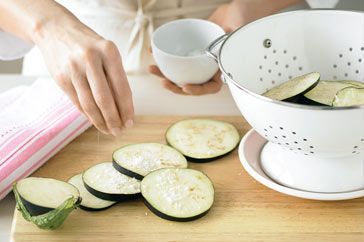A Joyful Journey of Prepping Eggplant for Cooking: A Comprehensive Guide for Parents
Introduction
Hey there, wonderful Parents! Looking for ideas to introduce new and nutritious veggies to your family’s meals? Or perhaps you already love eggplants but could use some tips to prepare it in more delicious, kid-friendly ways? We’ve got you covered! Welcome to this fun and informative guide on how to prep eggplant for cooking. Be ready for an exhilarating adventure through the eggplant world that will leave both you and your kids wanting more of this healthy delight!
Why Eggplant?
But first, let’s share a cheerful little secret about why you’d want to include eggplant in your meals. Eggplant, also known as aubergine or brinjal, is a vibrant purple veggie loaded with a plethora of nutrients. Not only are they a great source of vitamins and minerals, but they also have a unique texture and flavor that can jazz up a wide variety of dishes! Plus, it’s a brilliant way to sneak some additional nutrition into your kids’ meals – win-win!
Chapter 1: Selecting the Perfect Eggplant
Pick, Peek and Press: Finding Your Ideal Eggplant
The journey of prepping an eggplant efficiently starts way before you bring it to your kitchen counter. It begins at the grocery store or local farmers’ market. Look for eggplants that have a vibrant purple skin with no blemishes. They should feel firm but not hard when lightly squeezed. And remember, size matters! Smaller eggplants tend to be less bitter and have fewer seeds.
Chapter 2: Preparing the Eggplant
Clean, Chop, and CHEER! – Prepping Your Eggplant with Love
Once you’ve chosen your perfect eggplant, it’s time for a little pampering session. First, give it a nice rinse under cold water. Next, slice off the very top and bottom. Now, it’s time to decide how to chop it up depending on the recipe you’re following. Don’t forget the cheer part – cooking is always more fun when there’s joy in the process!
Please stay tuned for more chapters, where we reveal the secrets of salting, peeling, and cooking methods for your eggplants! Armed with these tips, we believe your eggplant dishes are sure to earn rave reviews from the little judges at home. Happy cooking!

Chapter 3: The Art of Salting Eggplants
Sprinkle, Sit, and Smile – The Salting Method Made Simple
Cooking eggplant is like creating an edible masterpiece, and salting is the secret ingredient! Salt can help extract any lingering bitterness, tightens and firms up the flesh, and leads to better texture in the final dish. Simply sprinkle salt on the sliced, diced, or halved eggplant pieces. Leave it sitting for about half an hour, then rinse and pat dry. Now, look at your handiwork and give yourself a beaming smile, because you’ve just prepped your eggplant like a pro!
Chapter 4: To Peel or not to Peel
Understanding Eggplant Peels: A Peeling Paradox
It’s not a quiz, so don’t worry! Here’s the deal with eggplant peels: they’re definitely edible, but can sometimes be slightly tough, particularly in larger eggplants. If you’re making a dish where the texture matters, like roasted eggplant dip, you might want to remove the skin before roasting. But if it’s for a hearty stew or stir-fry, leaving the skin on can add an exciting textural contrast. So, you see? Not a stressful decision at all!
Chapter 5: Cooking Your Eggplant
Stir, Sizzle and Savor – Unleashing the Magic of Eggplant
Now comes the grand finale – cooking your expertly prepped eggplant! Whether you choose to grill, roast, sauté, bake or stir-fry, the key to a delectable eggplant dish lies in cooking it thoroughly until it is creamy and tender. This is when the flavors truly come alive, and you get to savor the reward of your effort. Enjoy this eggplant extravaganza! Happy cooking!
And there you have it – a wholesome and cheerful guide on how to prep your eggplant for cooking. Get ready to surprise your family with a string of healthy, delicious, and artistically created meals. Let’s create some ‘Eggplant Magic’ together!
Preparing for How to Prep Eggplant for Cooking: A Guide for Parents
1. Choosing the Best Eggplants
You’ll be surprised how much result quality matters in dishes! To give your meals the freshest taste, always select eggplants that are firm to touch, have glossy skins and are relatively heavier. Small to medium sized ones are typically sweeter, having fewer seeds.
2. Proper Cleaning of Eggplant
Like other fruits and veggies, eggplants are susceptible to residue and bacteria. To ensure it’s safe for consumption, rinse them thoroughly under cold running water and dry off with a kitchen towel.
3. Knowing When to Peel or Not to Peel the Eggplant
Eggplant skin is edible and packed with fiber, antioxidants, and nutrients, so you don’t necessarily need to peel it. However, for some recipes or for those who find the skin too bitter, you can remove it.
4. Salting the Eggplant
To overcome the eggplant’s potential bitterness and to ensure it doesn’t absorb too much oil while cooking, salting is recommended. Slice or dice the eggplant, generously sprinkle it with salt, and leave it for at least 20 minutes. Rinse and dry before cooking.
5. Different Methods of Cooking Eggplant
Eggplants are extremely versatile and can be sautéed, baked, grilled, or fried. Each preparation provides a unique flavor and texture. Teaching your kids these various methods not only enriches their taste buds but also inspires their love for cooking.
Discovering how to prep eggplant for cooking can be a delightful experience for both parents and children. By following these guidelines, you can ensure that your family will be able to enjoy healthier, more delicious eggplant dishes!
For more great articles please see here. For more information see here
Disclaimer
The articles available via our website provide general information only and we strongly urge readers to exercise caution and conduct their own thorough research and fact-checking. The information presented should not be taken as absolute truth, and, to the maximum extent permitted by law, we will not be held liable for any inaccuracies or errors in the content. It is essential for individuals to independently verify and validate the information before making any decisions or taking any actions based on the articles.




